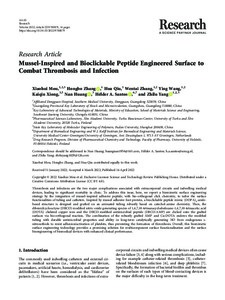Mussel-Inspired and Bioclickable Peptide Engineered Surface to Combat Thrombosis and Infection
Mou Xiaohui; Zhang Hongbo; Qiu Hua; Zhang Wentai; Wang Ying; Xiong Kaiqin; Huang Nan; Santos Hélder A.; Yang Zhilu
Mussel-Inspired and Bioclickable Peptide Engineered Surface to Combat Thrombosis and Infection
Mou Xiaohui
Zhang Hongbo
Qiu Hua
Zhang Wentai
Wang Ying
Xiong Kaiqin
Huang Nan
Santos Hélder A.
Yang Zhilu
AMER ASSOC ADVANCEMENT SCIENCE
Julkaisun pysyvä osoite on:
https://urn.fi/URN:NBN:fi-fe2022081154913
https://urn.fi/URN:NBN:fi-fe2022081154913
Tiivistelmä
Thrombosis and infections are the two major complications associated with extracorporeal circuits and indwelling medical devices, leading to significant mortality in clinic. To address this issue, here, we report a biomimetic surface engineering strategy by the integration of mussel-inspired adhesive peptide, with bio-orthogonal click chemistry, to tailor the surface functionalities of tubing and catheters. Inspired by mussel adhesive foot protein, a bioclickable peptide mimic (DOPA)(4)-azide-based structure is designed and grafted on an aminated tubing robustly based on catechol-amine chemistry. Then, the dibenzylcyclooctyne (DBCO) modified nitric oxide generating species of 1,4,7,10-tetraazacyclododecane-1,4,7,10-tetraacetic acid (DOTA) chelated copper ions and the DBCO-modified antimicrobial peptide (DBCO-AMP) are clicked onto the grafted surfaces via bio-orthogonal reaction. The combination of the robustly grafted AMP and Cu-DOTA endows the modified tubing with durable antimicrobial properties and ability in long-term catalytically generating NO from endogenous s-nitrosothiols to resist adhesion/activation of platelets, thus preventing the formation of thrombosis. Overall, this biomimetic surface engineering technology provides a promising solution for multicomponent surface functionalization and the surface bioengineering of biomedical devices with enhanced clinical performance.
Kokoelmat
- Rinnakkaistallenteet [27094]
